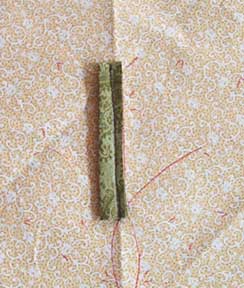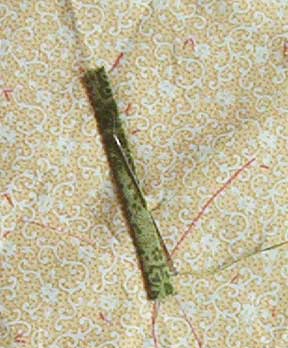Stems and Vines
Here, too, you will find many different options in preparing and sewing stems and vines, and you will have to experiment until you find which one you like best. After quite a bit of experimenting myself, I finally decided on this favorite method shared here. I like it because it is fast, but especially because it is precise. And an additional benefit is that because of the four layers involved, it gives my stems and vines dimension.
1. To begin, a couple of very simple guidelines. For straight stems, go ahead and cut your strips following the grainline. For curved stems and vines, however, make sure to always cut your strips on the bias.
2. The width of your strip will depend on the width of your finished stem or vine. Measure that width on the original pattern and multiply by 4. This is the width that you will want to use to cut your strips. (Most of mine I cut between 3/4 to 1", but have been know to cut as small as 1/2" wide for very narrow vines.)

3. Once you have decided and cut your strips the desired width, fold in half (wrong sides together) and press.
4. Use the pattern as a guide to cut out the stems about 1/2" longer than their size on the pattern (this allows plenty of fabric to place the stem under whatever pieces will be placed on top). With a fabric pencil or marker, trace a line down the middle of the folded stem - actually, from the middle of the stem a hairline over and towards the raw edges.

5. On your background block and using the original desgin, trace a line down the middle of where the stem/vine should be placed.

6. Align the raw edges of the folded stem with the traced line on the background block (if necessary, pin in place). Sew along the traced line of the stem with a running stitch (this step can be done by hand or machine).

7. Fold the stem over and press. Appliqué the folded edge onto the background using an invisible stitch.

Pretty easy, wouldn't you say? For curved stems follow the same process, following the curved line traced on the background. Likewise for long vines (as in borders). In this case, you will probably want to join several strips to give you the entire length of the border.
- Login to post comments








